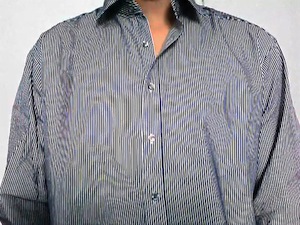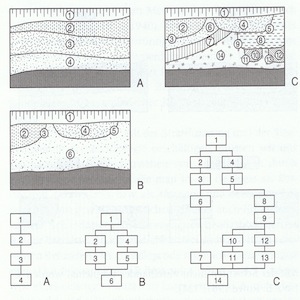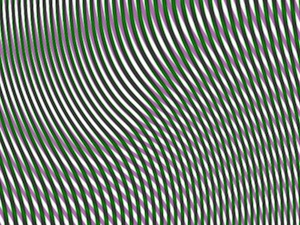[01.09.2015]
Moiré Archaeology:
Hallucinating the Past
|
The moiré effect induces distortion in the viewer. Phantom movement agitates the ocular canvas. The neurovelocity can't keep pace. Overlay one pattern upon another and the residue bleeds together. The human brain scatters this residue into a kinetic animation. We see a hallucination of layers. Layers, as archaeologists and geologists are aware, indicate temporality -- sequence and chronology. Moiré's deviant effect, though, can do much to reorganize chronocentric archaeological interpretation. Archaeologists penetrate layers to discern patterns or phenomena embedded in time. As such, an appreciation for the distorting effect of juxtaposed angles and voyeuristic gazing is critical.
|
|
The Harris Matrix, an archaeological fixture, exemplifies the sanitized perception of 'looking at' as opposed to 'looking through'. The Harris Matrix presents an unproblematic array of time depth -- one episode occurring or co-occurring in conjunction with the next without any leaking perceptual reverb. This a fantastic schematic if one's goal is to clearly parse and delineate phases, hermetically sealing causes from effects. This brand of interpretation, though, has been shown lacking along a number of horizons, specifically those highlighted by the various post-human and speculative realist manifestos liberating causality from the oppression of intentionality.
|

|

|
Imagine, please, that the Harris Matrix, or some mutant variation thereof, incorporated the moiré effect. We would see the hallucinatory aspect of the past. Rather literally, the past is revealed as a trompe l'oeil. This is challenging of course, but if archaeological interpretation is undertaken from this starting point -- that every layer of stratigraphy penetrated optically deludes its neighbor -- it opens entirely new corridors of interpretation. If we can see the distorted guts of excavated layers, a plurality of immaterial capacities becomes visible along with aesthetic exteriority. No stratigraphy is an encased replication of an event, and no event has ever been static. Why attempt to abstract stasis from breathing causality?
|
|
Moiré archaeology reads the material record as an illusion. We've always known this was the case, but much of 20th century archaeology attempted to erase this effect as though it were obfuscating some kind of clinical or clean reading of the past. The sentiment has been to drill through the durational scarring to get at the reality of past populations. But nothing has ever happened in the past -- occurrence belongs to the present, and sometimes that presence gets exhausted. The Past is hallucinated by the narrative causality of signaling objects. Compressing the layers of this hallucination into a two dimensional optical delusion allows the archaeologist to overcome the normalization of sequence as the primary arbiter of causality. All too often the tendency is to not trust this ocular prisming of layers because it is not amenable to the palatable digestion of meaning. |

|
|